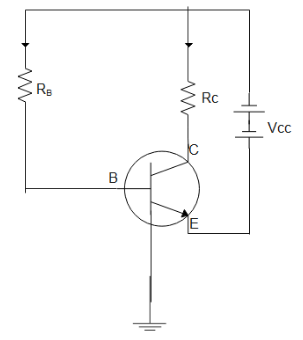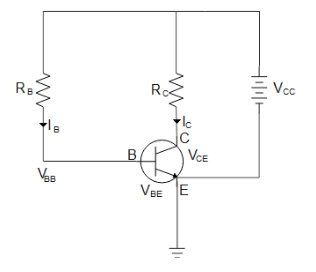
In the circuit shown, if ${V_{CE}} = 4{\text{V}}$ and ${R_B} = 200{\text{k}}\Omega $ , ${R_C} = 1{\text{k}}\Omega $, then find current gain.$({V_{BE}} = 0.4{\text{V)}}$


Answer
489.3k+ views
Hint: The configuration in which the emitter is connected between collector and base is called C-E (common-emitter) configuration. In such a circuit, input is provided between emitter and base whereas the output is taken between emitter and collector. In such a circuit problem apply Kirchhoff’s law to find the value of required quantities.
Complete step by step answer:
Before applying Kirchhoff’s law to the loops in the circuit let us define Kirchhoff’s law first.According to Kirchhoff’s law, the total current entering the node is the same as the total current exiting the node. This is true for any node randomly chosen.

First applying Kirchhoff’s law to the right-hand arm of the circuit we get
${V_{CC}} = {V_{CE}} + {I_C}{R_C}$
Substituting the values and rearranging we get,
$10 - {I_C} \times 1 \times {10^3} - 4 = 0$
Making current the subject of the equation
$ \Rightarrow {I_C} = \dfrac{{10 - 4}}{{{{10}^3}}}$
$ \Rightarrow {I_C} = 6{\text{mA}}$
Now applying Kirchhoff’s law to the left-hand arm of the circuit we get
${V_{BB}} = {V_{BE}} + {I_B}{R_B}$
Substituting the values and rearranging we get,
$10 - {I_B} \times 200 \times {10^3} - 0.4 = 0$
Making current the subject of the equation
$ \Rightarrow {I_B} = \dfrac{{10 - 0.4}}{{200 \times {{10}^3}}}$
$ \Rightarrow {I_B} = 0.048{\text{mA}}$
Therefore the current gain $\beta $ is
$\beta = \dfrac{{{I_C}}}{{{I_B}}}$
Substituting the values we get,
$\therefore \beta = 125$
Hence, the current gain is 125.
Additional information: In common emitter circuits, we get a large value of voltage gain and power gain whereas current gain is moderate. This ability of common emitter circuits is harnessed in developing advanced BJT where we get a stable and steady voltage supply, even though there is varying current gain.
Note: For solving such questions we need to apply Kirchhoff’s law separately to both arms. And we should be careful with the sign used for current and voltage. And to decide the type of configuration of the transistor we should see which arm of the transistor is grounded in the circuit diagram. The one which is grounded will be common in the configuration.
Complete step by step answer:
Before applying Kirchhoff’s law to the loops in the circuit let us define Kirchhoff’s law first.According to Kirchhoff’s law, the total current entering the node is the same as the total current exiting the node. This is true for any node randomly chosen.

First applying Kirchhoff’s law to the right-hand arm of the circuit we get
${V_{CC}} = {V_{CE}} + {I_C}{R_C}$
Substituting the values and rearranging we get,
$10 - {I_C} \times 1 \times {10^3} - 4 = 0$
Making current the subject of the equation
$ \Rightarrow {I_C} = \dfrac{{10 - 4}}{{{{10}^3}}}$
$ \Rightarrow {I_C} = 6{\text{mA}}$
Now applying Kirchhoff’s law to the left-hand arm of the circuit we get
${V_{BB}} = {V_{BE}} + {I_B}{R_B}$
Substituting the values and rearranging we get,
$10 - {I_B} \times 200 \times {10^3} - 0.4 = 0$
Making current the subject of the equation
$ \Rightarrow {I_B} = \dfrac{{10 - 0.4}}{{200 \times {{10}^3}}}$
$ \Rightarrow {I_B} = 0.048{\text{mA}}$
Therefore the current gain $\beta $ is
$\beta = \dfrac{{{I_C}}}{{{I_B}}}$
Substituting the values we get,
$\therefore \beta = 125$
Hence, the current gain is 125.
Additional information: In common emitter circuits, we get a large value of voltage gain and power gain whereas current gain is moderate. This ability of common emitter circuits is harnessed in developing advanced BJT where we get a stable and steady voltage supply, even though there is varying current gain.
Note: For solving such questions we need to apply Kirchhoff’s law separately to both arms. And we should be careful with the sign used for current and voltage. And to decide the type of configuration of the transistor we should see which arm of the transistor is grounded in the circuit diagram. The one which is grounded will be common in the configuration.
Recently Updated Pages
A man running at a speed 5 ms is viewed in the side class 12 physics CBSE

The number of solutions in x in 02pi for which sqrt class 12 maths CBSE

State and explain Hardy Weinbergs Principle class 12 biology CBSE

Write any two methods of preparation of phenol Give class 12 chemistry CBSE

Which of the following statements is wrong a Amnion class 12 biology CBSE

Differentiate between action potential and resting class 12 biology CBSE

Trending doubts
What are the major means of transport Explain each class 12 social science CBSE

Which are the Top 10 Largest Countries of the World?

Draw a labelled sketch of the human eye class 12 physics CBSE

How much time does it take to bleed after eating p class 12 biology CBSE

Explain sex determination in humans with line diag class 12 biology CBSE

Explain sex determination in humans with the help of class 12 biology CBSE




